
Salty Sam’s Fun Blog for Children
Post Number 22
Exploring Rivers
Hello Everyone

ln my last Post, l was telling you about how l made some bird boxes for Auntie Alice. Well, l enjoyed making them so much that l’m afraid that l got a bit carried away and made way too many for Auntie Alice’s garden.
So we decided to put all the spare ones up in the woods behind her cottage. Bill and Bob came to help me and next spring maybe we can go back and see how many have birds living in them.
There is a river running through this wood. All rivers start as little trickles and become narrow streams. They get wider and wider and at four meters wide a stream becomes a river.
lf you can’t jump over it, it isn’t a stream it is a river!
The river is very clean so there are lots of fish living in it and lots of mayflies hovering above it in the summertime. There are also animals that live in the banks as well. One of them is a shrew. A shrew is a tiny animal that looks like a little mouse but with a very long pointed nose. They are famous for being very bad-tempered!
There are also kingfishers living at the sides of the river – actually inside the mud banks. People love watching kingfishers because they are so colourful. They are turquoise and orange and love to sit on branches overhanging the river.
On the female the lower part of the beak is orange and on the male the beak is all black, that is how you can tell the difference.
The river flows down towards the sea and when the river meets the sea, the fresh water of the river mixes with the salty water of the sea. When these two kinds of water mix together it is called brackish water.
Some kinds of fish only live in fresh water and some only live in sea water. Some sea creatures (sometimes called marine creatures) are so big they couldn’t fit into a small river!
But some fish and mammals are able to live in both fresh and sea water; for example salmon and some seals and sharks.
Of course, there is lots of wildlife to see on the water as well like ducks and swans and other waterfowl.
Sometimes l take my nephews rowing on the river. lt is a safer place for them to row than on the sea because the water is much calmer. lt is a lovely place in the summer to spend a lazy day. ![]()
Bye bye everyone – don’t forget to subscribe to my blog!
Love and kisses
Salty Sam

www.christina-sinclair.com

![]()
Bill and Bob’s Joke of the Week![]()
![]()
Bob: Why are rivers lazy?
Bill: l don’t know. Why are rivers so lazy?
Bob: Because they never get off their beds!

Salty Sam © Christina Sinclair 2015
Unauthorized use and/or duplication of material from this blog without express and written permission from this blog’s author and owner is strictly prohibited.
Links may be used to www.christina-sinclair.com

Picture Gallery

Mayfly
 Shrew
Shrew
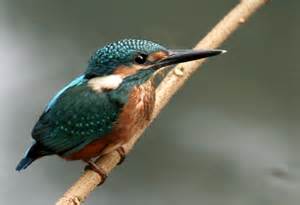 Kingfisher
Kingfisher
 Salmon
Salmon
 There are lots of different birds that like living on rivers
There are lots of different birds that like living on rivers
This is a mute swan – he was very friendly
 A mute swan
A mute swan
 A swan dabbling – it is looking for weed under the water
A swan dabbling – it is looking for weed under the water
 Life on the riverbank
Life on the riverbank
 Rushes and trees along river banks give shelter for nesting birds
Rushes and trees along river banks give shelter for nesting birds
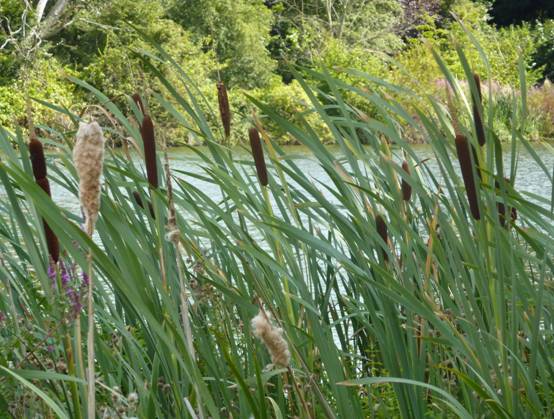 Bulrushes by the river
Bulrushes by the river
 Reeds by the river
Reeds by the river
 Weeping willows provide large canopies of cover for wildlife
Weeping willows provide large canopies of cover for wildlife
 Crack willows growing by the river bank – if a branch cracks off and falls into the river, it may plant itself in a bank downstream
Crack willows growing by the river bank – if a branch cracks off and falls into the river, it may plant itself in a bank downstream
Willows grow quite easily from cuttings
 Birds that live on the river, like ducks, coots and moorhens, often like to build raised nests out of sticks; this one is sheltering under a weeping willow but is well away from the bank and surrounded by water.
Birds that live on the river, like ducks, coots and moorhens, often like to build raised nests out of sticks; this one is sheltering under a weeping willow but is well away from the bank and surrounded by water.
 Canada geese
Canada geese
 A coot with a white top to its head and red eyes
A coot with a white top to its head and red eyes
 A pair of coots
A pair of coots
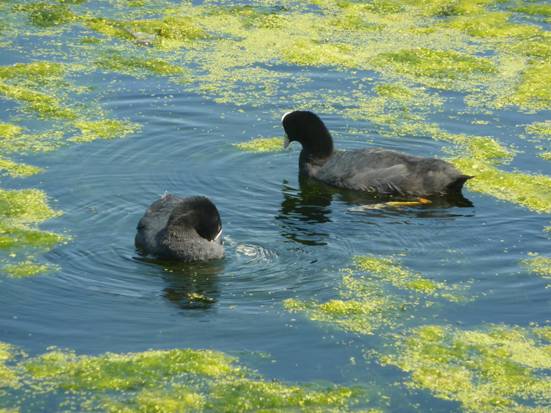 Two coots on the river on a sunny day
Two coots on the river on a sunny day
 Coots can be identified by their white faces
Coots can be identified by their white faces
 Moorhens have red faces
Moorhens have red faces
 They are much more timid than coots
They are much more timid than coots
 Baby swans are called cygnets
Baby swans are called cygnets
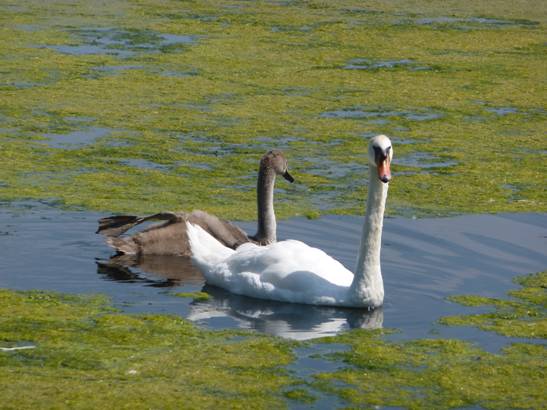 Cygnets stay with their parents while they are growing up
Cygnets stay with their parents while they are growing up
 This family has seven babies
This family has seven babies
 Sea gulls often come inland to look for food
Sea gulls often come inland to look for food
 As a river gets wider it can accommodate larger watercraft
As a river gets wider it can accommodate larger watercraft
(Boat trips at Hampton Court Palace)
 Thames boat rides from Westminster Bridge
Thames boat rides from Westminster Bridge
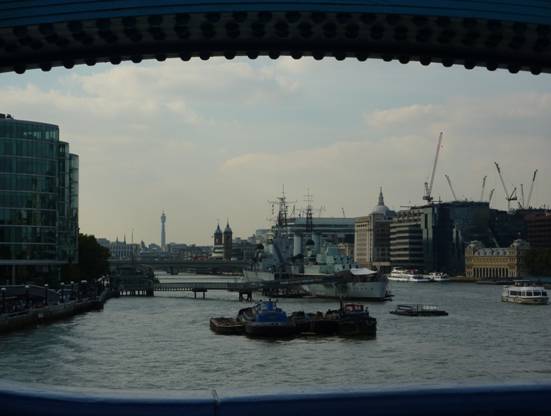 The Pool of London is very busy with craft (taken from Tower Bridge)
The Pool of London is very busy with craft (taken from Tower Bridge)
 It is said that each drop of rain that falls on the River Thames will be drunk by eight people before it goes back into the river to reach the sea
It is said that each drop of rain that falls on the River Thames will be drunk by eight people before it goes back into the river to reach the sea
 The Thames is a very clean river – over a hundred species of fish are to be found there
The Thames is a very clean river – over a hundred species of fish are to be found there
 Cormorants live where rivers become wider
Cormorants live where rivers become wider
 Roach
Roach
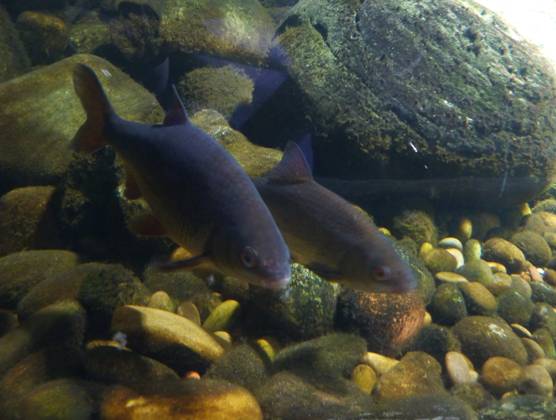 Grayling
Grayling
 Rudd
Rudd
(I think he likes having his photo taken ![]() )
)
 Perch
Perch
 There is always something interesting to see by the river – a heron peers through the reeds
There is always something interesting to see by the river – a heron peers through the reeds
 Different fish are found in different rivers – these pacu fish are to be found in South America
Different fish are found in different rivers – these pacu fish are to be found in South America
 Red-tailed cat fish from South America
Red-tailed cat fish from South America
![]()

 THE SALTY SAM NEWS DESK
THE SALTY SAM NEWS DESK

Bill and Bob learnt to swim when they were very tiny. Their mum and dad thought it was a very important thing to do.
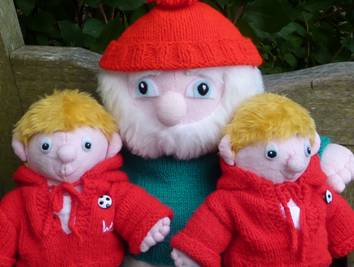
Bill and Bob learnt to swim in a very easy way. They started off swimming with a plastic blow-up ring that fitted around their waist and under their arms, and then they progressed to arm bands. Then they would swim with one of their parents holding the back of their swimming costume. One day they just let go without telling Bill and Bob they were going to and suddenly the boys were swimming by themselves for the first time – swimming has a lot to do with confidence. If you believe that you can swim, then you will be able to.
When they go out in a boat they always wear a life jacket though.
Miss Pringle their class teacher at the Rocky Bay Primary School sometimes takes her class swimming at the Rocky Bay Swimming Pool. It isn’t very big but it is a good place for children to learn. Swimming in the sea can sometimes be less safe because you can get currents in the water that pull you away from shore and of course, there isn’t a life guard always looking over the water on every beach to keep watch for anyone who might be getting into trouble.
Miss Pringle told the children that everyone should learn to swim because you never know when you might accidentally fall into a river or pond or canal or even the sea and your ability to swim will save your life.
She also taught the children that they should never dive into strange water head first – not even a swimming pool because you never know what is under the water. If you hit your head on something you can’t see from above the water, it would be very dangerous.
She told the children that they should never go swimming after a heavy meal. It is a good idea to wait until you have digested your food for a while otherwise you could get cramps which stop you from being able to swim properly.
Also, if you have long hair, you should tie it up in a swimming pool so that you don’t get it caught anywhere.
If you go to the seaside and there is a notice that tells you it is dangerous to swim there – don’t swim there.
She also said that if you ever go to help someone who is in trouble, always grab them from behind so that they can’t grab at you in their panic.
If you see someone in trouble in a canal or river in a city as you are walking along, it is better to throw them a life belt if you can find one rather than jump in yourself – especially if you are not a strong swimmer.

A lifebelt
Remember to keep hold of the other end of the rope if there is one so that you can drag them to the side; otherwise just try to throw the life belt as close to the person in the water as possible.
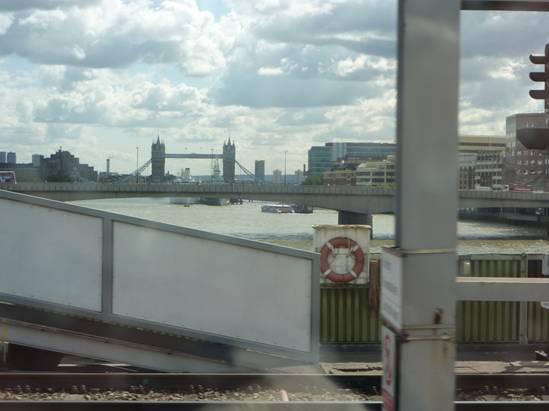
There are often lifebelts to be found by the river in public places

Sometimes lifebelts are inside cases

Never play with them or damage them – someone else might need one in a hurry.
And never walk across an icy pond – or let your dog do so in case you fall through the ice, because being in really cold water is very dangerous.
Miss Pringle said that you should never walk in streets that are covered in deep flood water either, because sometimes the manhole covers are removed by the force of the flood water surging upwards and there may be holes in the road or pavement that weren’t there before.
You probably won’t be able to see them because flood water is never very clear and you could fall into the hole.
These are all very good lessons to learn.

Bill, Henry and Bob

Rivers Quiz
Try this quiz out on your friends.
In which countries would you find these rivers?
- The River Thames
- River Forth
- River Towy
- The Murray River
- The Yangtze
- The Waikato River
- The Mackenzie River
- The Volga River
- The Tennessee River
- The River Shannon
- The Loire
- The River Ems
- The River Stor
- The river Ebro
- The Sao Francisco River
 Westminster Bridge on the Thames
Westminster Bridge on the Thames

Tower Bridge on the Thames

The Forth Bridge
on the Forth near Edinburgh

NEWSDESK MINIMAKE
A KNITTED DOLL PART TWO
Last week’s blog post had instructions on how to make a knitted doll.

Here are the instructions for completing the doll and next week there will be a pattern for a dress. In blog posts to come there will be more outfits for you to make for your doll.
All these patterns are really easy to do. The doll and the outfits are just basically made out of rectangles of knitting. There is no increasing of decreasing – you just have to know the knit stitch and the purl stitch to make this doll and all her outfits.

To make the hair for the doll on last week’s blog post:
Wrap some yellow yarn 70 times around a piece of card 16cm wide.
Sew across the strands of yarn with another length of yarn threaded into a yarn needle (right in the centre of the card).
Make sure every strand is secured.
This sewing line will create a centre parting.
Cut across the yarn on the opposite side of the card.
Wrap some yellow yarn 100 times around some card 11cm across.
Sew across the yarn 2cm from the edge of the card.
Cut across the strands at the edge of the card to create a fringe.
Position the centre parting on to the centre of top of the head and sew into place with more yarn.
Place the fringe where you want it to be and sew into position using more yarn across the line you have already made.
Arrange the hair around the doll’s head and very carefully trim the bottom to neaten.
 Put the hair across the doll’s head
Put the hair across the doll’s head

Put the fringe at the front of the head

Of course you can make a doll in any colours you like. You could make a doll in ecru with black hair or pink with purple hair; the choice is yours.
You could make more than one doll and they could be sisters or friends.

UNDERWEAR (KNIT ONE)
Using 3½mm knitting needles and white dk yarn cast on 44 stitches
(Knit 1, purl 1) repeat last 2 stitches to end of row
Repeat the last row 3 times (4 rows of ribbing)
Change to 4mm knitting needles
Knit 14 rows of stocking stitch
Knit 4 rows of garter stitch
Cast off
TIP
Slip the first stitch of every row to give a neat edge to your knitting
TO MAKE UP
Sew down the back seam right sides together
Turn the work right side out
Put a few stitches at the bottom of the seam to sew the front and back together

Next week there will be a dress for you to make to start a wardrobe for your knitted doll.
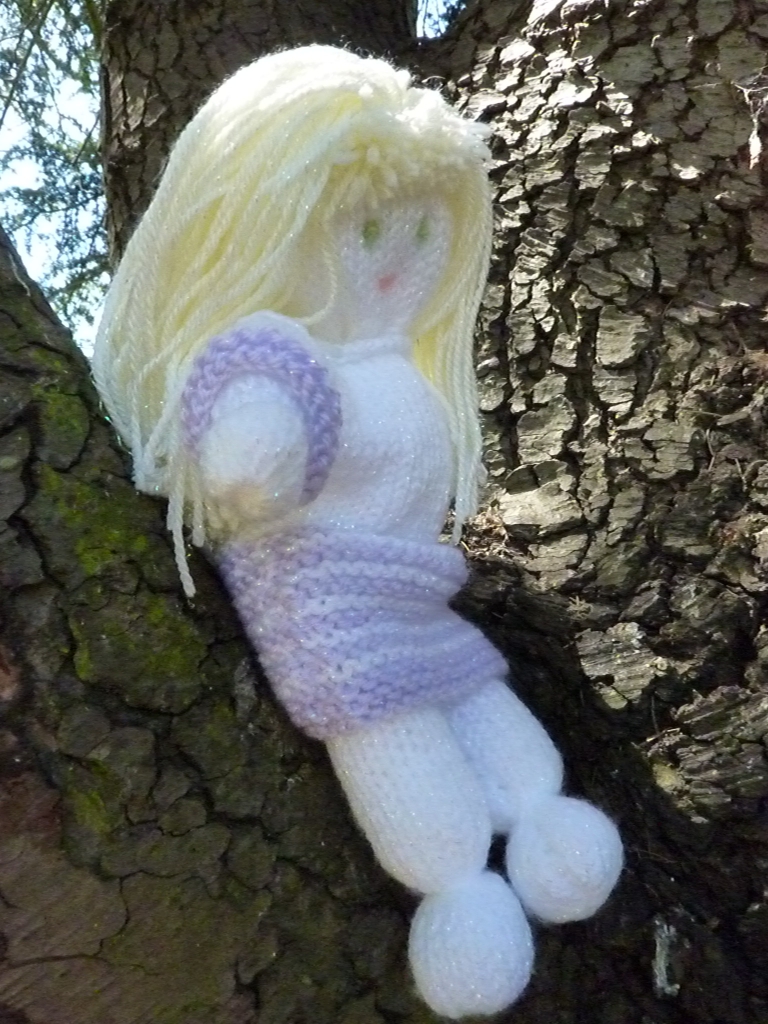

 Me writing my blog
Me writing my blog
And now an update on my blog.
The latest places to be reading my blog are Uruguay and the Bahamas, so a warm welcome to all of you!
There was also an enormous surge of visitor numbers from France last week, and quite a few visitors from the USA and Sweden and the Netherlands this week – so a big hello to all of you as well!
A lot of people have been writing in to say how much they are enjoying my blog and they hope that I keep writing it, so a special thank you to all of you for that.
![]()
The more readers I have, the easier it will be for me to continue to write, so please everyone, tell everybody you know about my blog – all your Facebook and Twitter friends, all your friends at school, your cousins and neighbours and even your teacher.
Please spread the word! ![]()
If you are learning to read or you are learning English, my blog should help you.
If you have trouble understanding any part of my blog, don’t forget that you can copy and paste it into Google Translate and that will translate any part that you have difficulty understanding into your own language.
If you are a teacher, you can use parts of my blog as material for your lessons.
Thank you everyone for your support! ![]()

*********************
TO ADVERTISE ON THIS BLOG
PLEASE CONTACT:
christina.sinclair.ads@aol.co.uk
*********************


Recipe Spot
lf you have ever been given biscuit/cookie cutters and a rolling pin as a present, this is a good scone recipe to try them out on.
Scones are a nice thing to take on a picnic by the river – or anywhere else you go for a picnic. ![]()
Ask permission to use the oven. Your mum or dad might prefer it if you do the weighing, mixing, rolling and cutting parts and they deal with the oven part. Ask them before you start and don’t forget to wash your hands before you start as well.
Preheat your oven to 230°c
Grease a baking sheet (you can use the inside of a butter wrapping paper)
225g/8ozes self-raising flour
½ teaspoon salt
50g/2ozes butter
150ml/¼pint milk

25g/1oz sugar and 50g/2oz of sultanas or chocolate chips for sweet scones
OR
50g/2oz grated cheddar, 1 teaspoon of mustard powder and a pinch of cayenne pepper for savoury scones
DO NOT ADD EVERYTHlNG – CHOOSE SWEET OR SAVOURY

- Put the flour and salt into a bowl
- Add the butter and rub in with your fingers until the mixture looks like breadcrumbs
- At this point add your sultanas and sugar OR cheese, mustard and cayenne
- Add the milk and mix together with a wooden spoon
- When your dough has all stuck together turn it out onto a floured surface
- Knead until it is smooth and roll it out until it is about 4cm/1½ inches thick (lt is a good idea to make scones that are quite tall, they will be much better than flat ones)
- Now you can use your cutters to make round scones
- Put them onto a greased baking sheet
- Pull all the remaining dough together, roll out and cut out some more scones then keep doing this until you have turned all the dough into scones
- Brush the tops with milk
- Bake for 10- 12 minutes at 230°c
- Leave to cool on a wire rack
Serve the sweet scones with butter or jam and cream
ln our part of the world of course we are lucky enough to have clotted cream to use. ![]()

![]()
BLOW MY FOGHORN!!!

PLUS
Salty Sam fans can join in with their comments and share them with children all over the world. You will need permission if you are not an adult.
Enter your e-mail address to subscribe to my blog and receive new Salty Sam Blog Posts for free by e-mail every week. Your address will be kept private and will not be shared with any third party.
Sign me up at the side bar



![]()
lt’s the Weekend!

HOW TO MAKE REPEAT PATTERNS
It is easier to draw inside a shape than around it, so a really easy way of making a repeat pattern is to use a stencil.
You can make your own.
Take a piece of thin card, fold it in half and cut a simple shape into the fold. The shape will be symmetrical when you lay the card flat again.

Lay your stencil down on a piece of paper and draw around the outside edge of the hole you have created. Then position the card at a different angle in a different place and draw the shape again. Go slowly otherwise your pen could slip spoiling your design.
Then you could colour your shapes in if you wanted to.
These water droplet shapes are really easy to do.

This fish design is an example of what you can achieve. It is simple but effective and you don’t have to be good at drawing. The eyes are drawn in afterwards.
You can then use the paper to cover a book or box lid. (Blog Post 15)

But you can take the design further. You can colour the fish in orange and draw blue spots between them. Or you can take another piece of card and cut a wavy line along one side and use it to draw wavy lines across your paper diagonally between the fish. Then you can colour in every other stripe blue.
Or you could just draw blue squiggly lines between the fish freehand.
Or you could colour each fish a different colour or even put a different jazzy design on each one.
Or you could use your fish to draw a little picture to go on the front of a birthday card. Draw a few fish swimming backwards and forwards and some stones and weed at the bottom of the picture and then colour it in.

But you can also put two shapes together across the surface of your paper. You can colour one shape in one colour and another in another colour, or you can use lots of colours.

Look around the house and you will probably find other objects like pieces of card, rulers and toys that already have shapes cut into them. They can provide interesting shapes to create repeat patterns.

Please note that the material on this blog is for personal use or for use in classrooms only.
It is a copyright infringement and, therefore, illegal under international law to sell items made with these patterns.
Use of the toys and projects on all of these blogs is at your own risk.
©Christina Sinclair Designs 2015
![]()
Answers to News Desk Quiz
- England
- Scotland
- Wales
- Australia
- China
- New Zealand
- Canada
- Russia
- The USA
- Ireland
- France
- Germany
- Denmark
- Spain
- Brazil

Salty Sam says everyone should learn how to swim.
![]()



I was looking at some of your posts on this site and I conceive this internet site is very instructive! Continue putting up.
I love your writing, please keep it up!
Thank you for writing in!